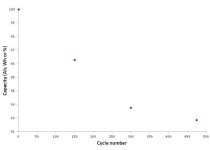flippy
1 MW
- Joined
- Aug 12, 2015
- Messages
- 2,351
Due to a cronic lack of decent testing results i concluluded that someone has to bite the bullet for this so i am planning on buying a 8 channel battery tester in order to finally get to the fine details on what is the best way to make your cells last as long as possible.
so far my plans have testing of the panasonic PF and GA cells as i have a bunch of those on hand.
my plans are to have each channel do different runs.
i base my testing currents on factory limits and what loads they might see during actual usage in scooters with different sized battery packs.
for these tests i dont use all 8 channels so i have a few left for weird/unusual/torture tests.
so far i have these tests figured out for my use cases:
4.2>3 at 2A discharge and .7A charge with 5A peaks each 5 min for 10 seconds
4.1>3 at 2A discharge and .7A charge with 5A peaks each 5 min for 10 seconds
4.05>3 at 2A discharge and .7A charge with 5A peaks each 5 min for 10 seconds
4.05>3 at 3A discharge and .7A charge with 5A peaks each 5 min for 10 seconds
4.05>3 at 4A discharge and .7A charge with 7A peaks each 5 min for 10 seconds
i plan to run 1000 runs for each channel or until they basically die, whatever comes first.
i would love to hear some cycle testing parameters from you guys and reasons why it should be included.
if you have cells that you want to see tested and want to send them to me i will test them after these have finished their runs you can send me a message for shipping details.
results will be public and posted here.
so far my plans have testing of the panasonic PF and GA cells as i have a bunch of those on hand.
my plans are to have each channel do different runs.
i base my testing currents on factory limits and what loads they might see during actual usage in scooters with different sized battery packs.
for these tests i dont use all 8 channels so i have a few left for weird/unusual/torture tests.
so far i have these tests figured out for my use cases:
4.2>3 at 2A discharge and .7A charge with 5A peaks each 5 min for 10 seconds
4.1>3 at 2A discharge and .7A charge with 5A peaks each 5 min for 10 seconds
4.05>3 at 2A discharge and .7A charge with 5A peaks each 5 min for 10 seconds
4.05>3 at 3A discharge and .7A charge with 5A peaks each 5 min for 10 seconds
4.05>3 at 4A discharge and .7A charge with 7A peaks each 5 min for 10 seconds
i plan to run 1000 runs for each channel or until they basically die, whatever comes first.
i would love to hear some cycle testing parameters from you guys and reasons why it should be included.
if you have cells that you want to see tested and want to send them to me i will test them after these have finished their runs you can send me a message for shipping details.
results will be public and posted here.


